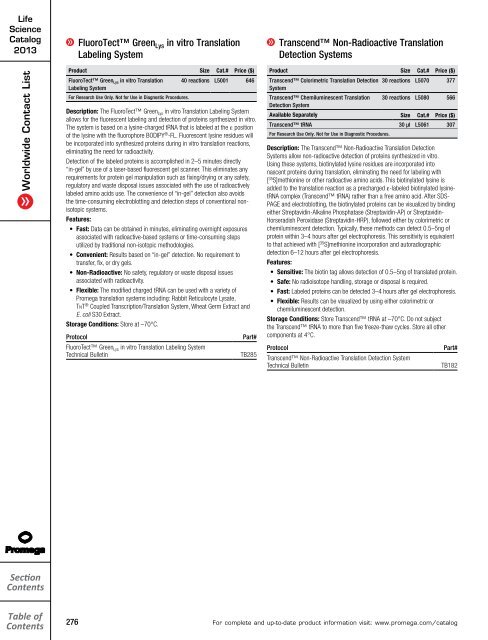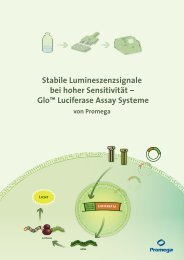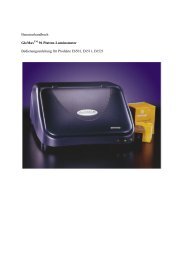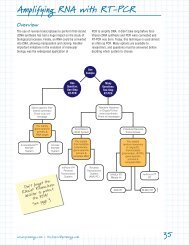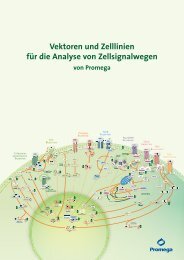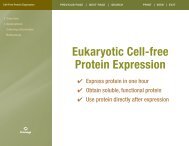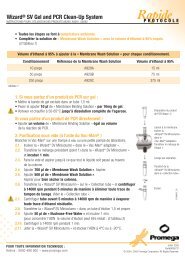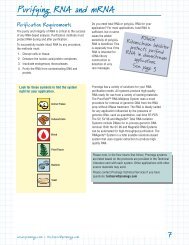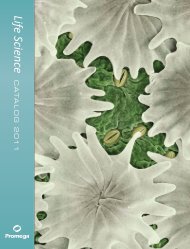2013 Promega catalogue
2013 Promega catalogue
2013 Promega catalogue
You also want an ePaper? Increase the reach of your titles
YUMPU automatically turns print PDFs into web optimized ePapers that Google loves.
Life<br />
Science<br />
Catalog<br />
<strong>2013</strong><br />
Worldwide Contact List<br />
Cell Signaling<br />
FluoroTect Green Lys in vitro Translation<br />
Labeling System<br />
Product Size Cat.# Price ($)<br />
FluoroTect Green Lys in vitro Translation<br />
Labeling System<br />
For Research Use Only. Not for Use in Diagnostic Procedures.<br />
40 reactions L5001 646<br />
Description: The FluoroTect Green Lys in vitro Translation Labeling System<br />
allows for the fluorescent labeling and detection of proteins synthesized in vitro.<br />
The system is based on a lysine-charged tRNA that is labeled at the ε position<br />
of the lysine with the fluorophore BODIPY ® -FL. Fluorescent lysine residues will<br />
be incorporated into synthesized proteins during in vitro translation reactions,<br />
eliminating the need for radioactivity.<br />
Detection of the labeled proteins is accomplished in 2–5 minutes directly<br />
“in-gel” by use of a laser-based fluorescent gel scanner. This eliminates any<br />
requirements for protein gel manipulation such as fixing/drying or any safety,<br />
regulatory and waste disposal issues associated with the use of radioactively<br />
labeled amino acids use. The convenience of “in-gel” detection also avoids<br />
the time-consuming electroblotting and detection steps of conventional nonisotopic<br />
systems.<br />
Features:<br />
• Fast: Data can be obtained in minutes, eliminating overnight exposures<br />
associated with radioactive-based systems or time-consuming steps<br />
utilized by traditional non-isotopic methodologies.<br />
• Convenient: Results based on “in-gel” detection. No requirement to<br />
transfer, fix, or dry gels.<br />
• Non-Radioactive: No safety, regulatory or waste disposal issues<br />
associated with radioactivity.<br />
• Flexible: The modified charged tRNA can be used with a variety of<br />
<strong>Promega</strong> translation systems including: Rabbit Reticulocyte Lysate,<br />
TnT ® Coupled Transcription/Translation System, Wheat Germ Extract and<br />
E. coli S30 Extract.<br />
Storage Conditions: Store at –70°C.<br />
Protocol<br />
FluoroTect Green Lys in vitro Translation Labeling System<br />
Technical Bulletin<br />
Part#<br />
TB285<br />
Transcend Non-Radioactive Translation<br />
Detection Systems<br />
Product Size Cat.# Price ($)<br />
Transcend Colorimetric Translation Detection 30 reactions L5070 377<br />
System<br />
Transcend Chemiluminescent Translation 30 reactions L5080 566<br />
Detection System<br />
Available Separately Size Cat.# Price ($)<br />
Transcend tRNA 30 μl L5061 307<br />
For Research Use Only. Not for Use in Diagnostic Procedures.<br />
Description: The Transcend Non-Radioactive Translation Detection<br />
Systems allow non-radioactive detection of proteins synthesized in vitro.<br />
Using these systems, biotinylated lysine residues are incorporated into<br />
nascent proteins during translation, eliminating the need for labeling with<br />
[ 35 S]methionine or other radioactive amino acids. This biotinylated lysine is<br />
added to the translation reaction as a precharged ε-labeled biotinylated lysinetRNA<br />
complex (Transcend tRNA) rather than a free amino acid. After SDS-<br />
PAGE and electroblotting, the biotinylated proteins can be visualized by binding<br />
either Streptavidin-Alkaline Phosphatase (Streptavidin-AP) or Streptavidin-<br />
Horseradish Peroxidase (Streptavidin-HRP), followed either by colorimetric or<br />
chemiluminescent detection. Typically, these methods can detect 0.5–5ng of<br />
protein within 3–4 hours after gel electrophoresis. This sensitivity is equivalent<br />
to that achieved with [ 35 S]methionine incorporation and autoradiographic<br />
detection 6–12 hours after gel electrophoresis.<br />
Features:<br />
• Sensitive: The biotin tag allows detection of 0.5–5ng of translated protein.<br />
• Safe: No radioisotope handling, storage or disposal is required.<br />
• Fast: Labeled proteins can be detected 3–4 hours after gel electrophoresis.<br />
• Flexible: Results can be visualized by using either colorimetric or<br />
chemiluminescent detection.<br />
Storage Conditions: Store Transcend tRNA at –70°C. Do not subject<br />
the Transcend tRNA to more than five freeze-thaw cycles. Store all other<br />
components at 4°C.<br />
Protocol<br />
Transcend Non-Radioactive Translation Detection System<br />
Technical Bulletin<br />
Part#<br />
TB182<br />
Section<br />
Contents<br />
Table of<br />
Contents<br />
276<br />
For complete and up-to-date product information visit: www.promega.com/catalog


